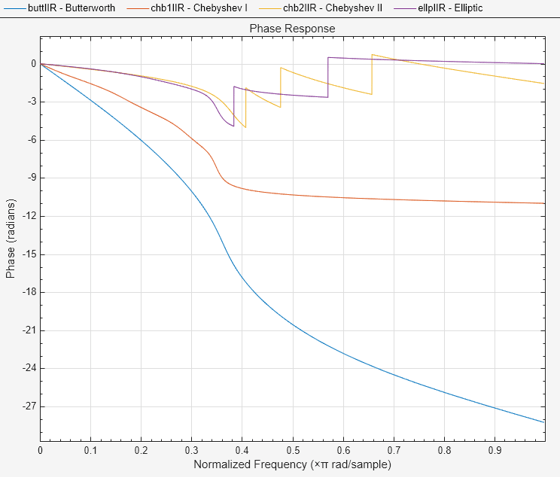islinphase
Verify that discrete-time filter System object is linear phase
Syntax
Description
flag = islinphase(___,Arithmetic=arithType)arithType input
using either of the previous syntaxes.
For more input options, see islinphase in Signal Processing Toolbox™.
Examples
Use the window method to design a 10th order lowpass FIR filter with the normalized cutoff frequency of 0.55. Verify that the filter has linear phase.
firSpecs = fdesign.lowpass('N,Fc',10,0.55); lpFIR = design(firSpecs,'window',SystemObject=true)
lpFIR =
dsp.FIRFilter with properties:
Structure: 'Direct form'
NumeratorSource: 'Property'
Numerator: [0.0036 0.0078 -0.0375 -0.0334 0.2856 0.5477 0.2856 -0.0334 -0.0375 0.0078 0.0036]
InitialConditions: 0
Show all properties
flag = islinphase(lpFIR)
flag = logical
1
Plot the phase response of the filter and verify that it is linear.
[phs,w] = phasez(lpFIR); plot(w/pi,phs) xlabel('Frequency \omega/\pi') ylabel('Phase')

IIR filters in general do not have linear phase. Verify this by constructing Butterworth, Chebyshev, and elliptic filters with similar specifications. Set the passband frequency to 0.35, stopband frequency to 0.4, passband ripple to 1 dB, and stopband attenuation to 20 dB.
Wp = 0.35; Wst = 0.4; atten = 20; rippl = 1; buttSpecs = fdesign.lowpass('Fp,Fst,Ap,Ast',Wp,Wst,rippl,atten); buttIIR = design(buttSpecs,'butter',SystemObject=true); chb1Specs = fdesign.lowpass('Fp,Fst,Ap,Ast',Wp,Wst,rippl,atten); chb1IIR = design(chb1Specs,'cheby1',SystemObject=true); chb2Specs = fdesign.lowpass('Fp,Fst,Ap,Ast',Wp,Wst,rippl,atten); chb2IIR = design(chb2Specs,'cheby2',SystemObject=true); ellpSpecs = fdesign.lowpass('Fp,Fst,Ap,Ast',Wp,Wst,rippl,atten); ellpIIR = design(ellpSpecs,'ellip',SystemObject=true);
Plot the phase responses of the filters. Determine whether they have linear phase.
fv = filterAnalyzer(buttIIR,chb1IIR,chb2IIR,ellpIIR,Analysis='phase'); setLegendStrings(fv,["Butterworth","Chebyshev I","Chebyshev II","Elliptic"])

phs = [islinphase(buttIIR) islinphase(chb1IIR) ...
islinphase(chb2IIR) islinphase(ellpIIR)]phs = 1×4 logical array
0 0 0 0
Input Arguments
Tolerance value to determine when two numbers are close enough to be considered
equal, specified as a positive scalar. If not specified, tol,
defaults to eps^(2/3).
Arithmetic used in the filter analysis, specified as 'double',
'single', or 'Fixed'. When the arithmetic
input is not specified and the filter System object is unlocked, the analysis tool assumes a double-precision filter. When the
arithmetic input is not specified and the System object is locked, the function performs the analysis based on the data type of
the locked input.
The 'Fixed' value applies to filter System objects with fixed-point
properties only.
When the 'Arithmetic' input argument is specified as
'Fixed' and the filter object has the data type of the
coefficients set to 'Same word length as input', the arithmetic
analysis depends on whether the System object is unlocked or locked.
unlocked –– The analysis object function cannot determine the coefficients data type. The function assumes that the coefficients data type is signed, has a 16-bit word length, and is auto scaled. The function performs fixed-point analysis based on this assumption.
locked –– When the input data type is
'double'or'single', the analysis object function cannot determine the coefficients data type. The function assumes that the data type of the coefficients is signed, has a 16-bit word length, and is auto scaled. The function performs fixed-point analysis based on this assumption.
To check if the System object is locked or unlocked, use the isLocked function.
When the arithmetic input is specified as 'Fixed' and the filter
object has the data type of the coefficients set to a custom numeric type, the object
function performs fixed-point analysis based on the custom numeric data type.
Output Arguments
Flag to determine if the filter has linear phase, returned as a logical:
1–– Filter has linear phase.0–– Filter has nonlinear phase.
Data Types: logical
Version History
Introduced in R2013aStarting in R2024b, the islinphase analysis function supports the
dsp.VariableFIRDecimator and dsp.VariableFIRInterpolator objects.
The dsp.BiquadFilter object issues a warning and will be removed in a
future release. Use the dsp.SOSFilter object
instead. For more information on how to replace your existing code, see the
Compatibility Considerations section in the dsp.BiquadFilter reference page.
Starting in R2024b, this function supports the dsp.DCBlocker object.
Starting in R2023b, the islinphase analysis function supports the
dsp.ParallelFilter
and the dsp.Delay objects.
The dsp.BiquadFilter object will be removed in a future release. Use
the dsp.SOSFilter object
instead.
See Also
MATLAB Command
You clicked a link that corresponds to this MATLAB command:
Run the command by entering it in the MATLAB Command Window. Web browsers do not support MATLAB commands.
选择网站
选择网站以获取翻译的可用内容,以及查看当地活动和优惠。根据您的位置,我们建议您选择:。
您也可以从以下列表中选择网站:
如何获得最佳网站性能
选择中国网站(中文或英文)以获得最佳网站性能。其他 MathWorks 国家/地区网站并未针对您所在位置的访问进行优化。
美洲
- América Latina (Español)
- Canada (English)
- United States (English)
欧洲
- Belgium (English)
- Denmark (English)
- Deutschland (Deutsch)
- España (Español)
- Finland (English)
- France (Français)
- Ireland (English)
- Italia (Italiano)
- Luxembourg (English)
- Netherlands (English)
- Norway (English)
- Österreich (Deutsch)
- Portugal (English)
- Sweden (English)
- Switzerland
- United Kingdom (English)